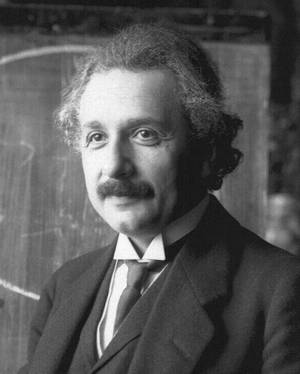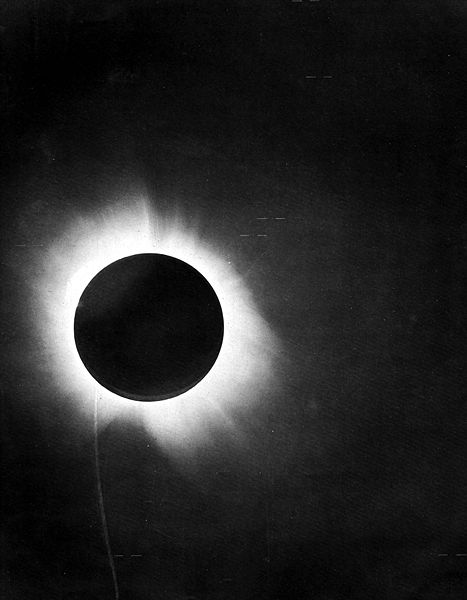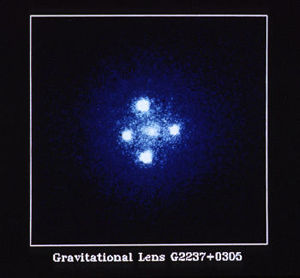This Week in Science History - Proof of General Relativity
Interview with
This Week in Science History saw in 1919, the solar eclipse that proved Albert Einstein's theory of general relativity to be correct.
 Einstein had published his theory in 1916, but because of the First World War, no attempts were made to test the theory until the English physicist Arthur Eddington and his colleagues travelled to observe the total solar eclipse of May 29th from Principe, off West Africa, and from northern Brazil.
Einstein had published his theory in 1916, but because of the First World War, no attempts were made to test the theory until the English physicist Arthur Eddington and his colleagues travelled to observe the total solar eclipse of May 29th from Principe, off West Africa, and from northern Brazil.
Before Einstein, Newton's theory of gravitation, put forward in his Principia Mathematica, published in the mid 17th century, had been the way to describe how gravity works. However, it could not account for what caused gravity and the source of the force. Newton himself was uncomfortable with how to explain how gravity seemed to 'act at a distance' through a vacuum.
Einstein's theory of general relativity gives rise to a geometric theory of gravitation. This basically says that gravity doesn't make things move - it is a consequence of the shape of 'spacetime'. The best way to imagine this is the common analogy of a rubber sheet. If you (and some friends) stretch it out so it's flat, then roll a ball from one side to the other, the ball will go straight across. But if you then put a big heavy ball in the middle of the sheet, it will cause a big dent in it - this is kind of like what happens to spacetime around a huge object like our sun - it changes shape. If you then roll the same ball as before across the rubber sheet, it won't just roll straight across - because the big ball in the middle has created a dip, the path of the small ball will change - it may bend, or roll right round the dip and come back towards you, or it might stay rolling around the big heavy ball. This is what gravity does - the dip in the sheet caused by the big ball is affecting the path of other objects put on the sheet. Just like gravity in the real world will affect the movement of objects and light coming close to a massive object like a star.
 The idea that light travelling towards us from distant stars would be bent by the gravitational pull of large objects like the Sun was suggested before the 1915 paper and could be predicted by combining Newton's theory of gravity with Einstein's earlier theory on special relativity. Using the now famous equation E=mc2 to calculate a mass for the light energy coming from a distant star, Newtonian gravitation predicts that the light will be bent by the sun's gravity, causing the perceived position of that star in the sky to shift. However, in his 1916 paper, Einstein predicted a displacement of *twice* that predicted by Newtonian gravitation, and the only way to prove who was right would be through observation.
The idea that light travelling towards us from distant stars would be bent by the gravitational pull of large objects like the Sun was suggested before the 1915 paper and could be predicted by combining Newton's theory of gravity with Einstein's earlier theory on special relativity. Using the now famous equation E=mc2 to calculate a mass for the light energy coming from a distant star, Newtonian gravitation predicts that the light will be bent by the sun's gravity, causing the perceived position of that star in the sky to shift. However, in his 1916 paper, Einstein predicted a displacement of *twice* that predicted by Newtonian gravitation, and the only way to prove who was right would be through observation.
The only time that stars could be observed when their position in the sky was close to the sun was during an eclipse, or the sun's brightness would prevent photographs of the stars from being taken. This led to the expeditions made by Eddington and his colleagues in 1919.
On the day of the eclipse, it was cloudy in Principe. Eddington and his assistant worried that they would not get the photographs they needed. Fortunately for the future of physics, the clouds broke for long enough.
 Back in England, they compared the photographs of the Hyades star field taken during the eclipse to photographic plates of the same star field when the sun was out of the way. The difference in position of the stars was just as Einstein had predicted - twice that of Newton's theory.
Back in England, they compared the photographs of the Hyades star field taken during the eclipse to photographic plates of the same star field when the sun was out of the way. The difference in position of the stars was just as Einstein had predicted - twice that of Newton's theory.
Throughout the 20th century, further evidence to support Einstein's general relativity theory has built up. The theory predicted the existence of black holes, gravitational redshift and gravitational time dilation, and the results of tests have all fitted with the theory's predictions.General relativity is still the way we describe gravity in modern physics, although there are problems when it comes to quantum physics - the physics of the particles that make up atoms, in that the predictions of relativity do not hold on this tiny scale. Reconciling these two areas would lead to a so called 'theory of everything'.










Comments
Add a comment